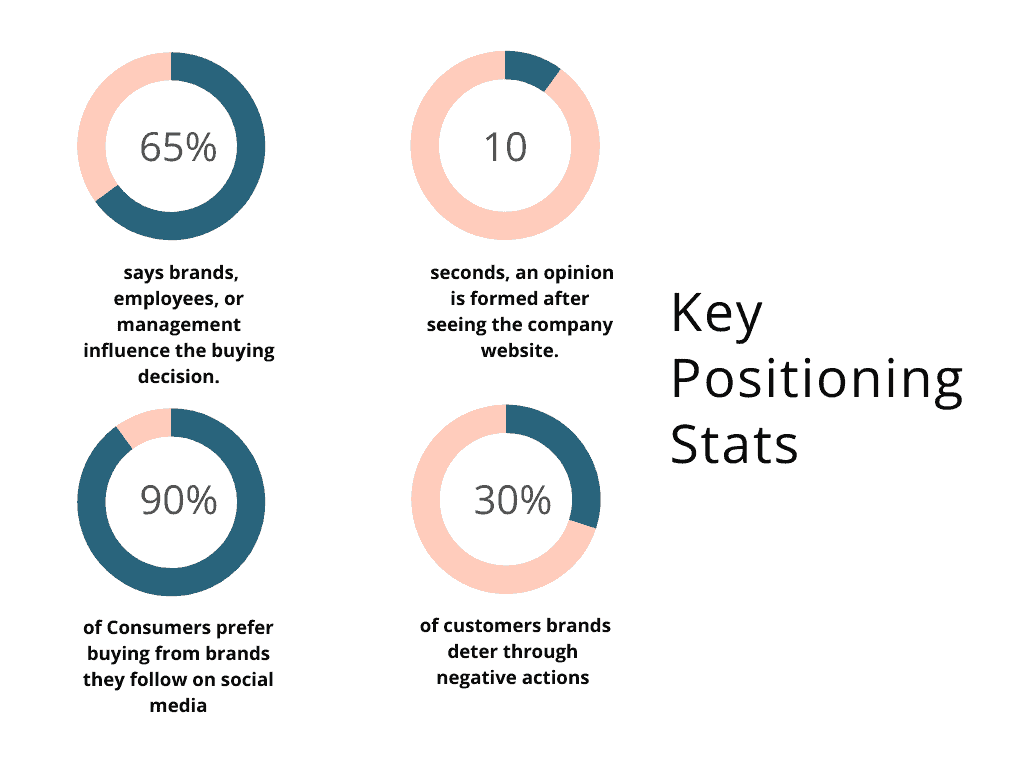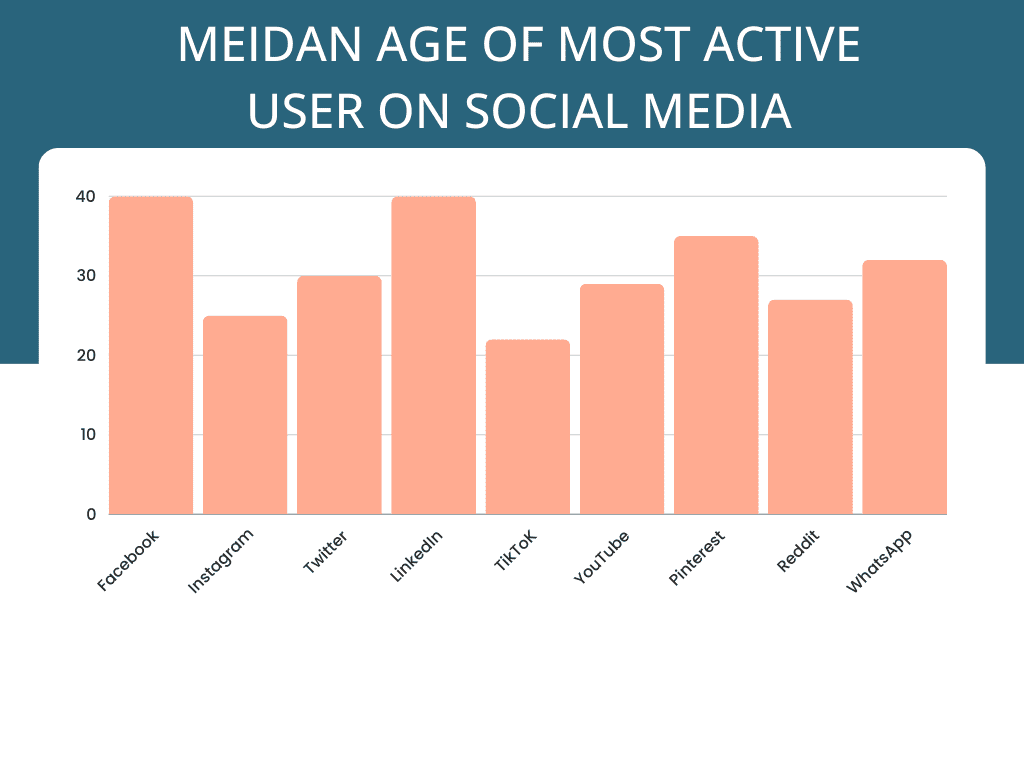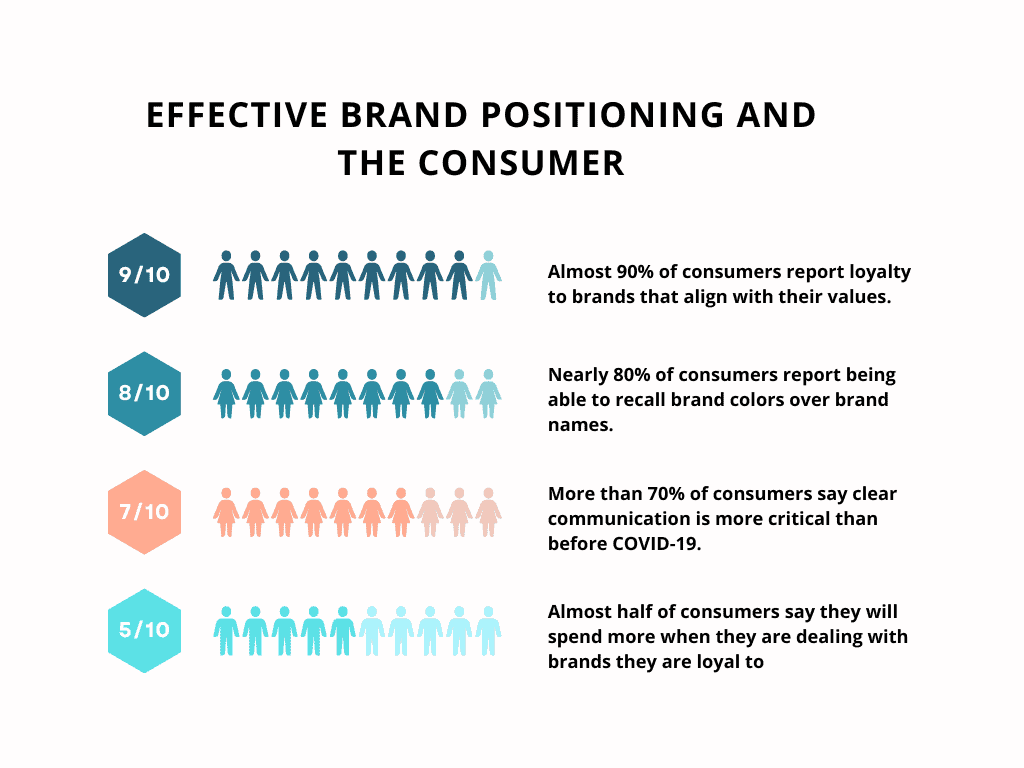In today’s ever-evolving and crowded marketplace, understanding the importance of brand positioning is necessary for any brand looking to stand out.
Your positioning strategy is like choosing the perfect spot in that marketplace, where your voice is heard loudest and clearest.
As we navigate this cacophony of endless choices and relentless competition, understanding and effectively implementing a marketing positioning strategy has essential for businesses to survive and thrive.
As a business owner or marketer, you’re constantly seeking ways to elevate your brand and carve out a unique space in the crowded market.
Developing a positioning strategy is how you will tell the consumer, here I am and this is what makes me different.
This blog delves into the importance of brand positioning. It will show you how to navigate the intricate dance of differentiating your brand’s voice, carving a unique identity, and creating a lasting connection with your audience in an environment where attention is the hardest currency to earn.

Understanding Positioning Strategy in the Marketing Action Plan Maze
With effective positioning strategies, you can make your brand the go-to choice for a specific audience with a product or service they can’t find elsewhere.
Business owners spend much of their time and focus on creating a great product or service. While providing value is essential to any company’s success, it’s equally important to understand how you can portray this value and differentiate yourself from the competition.
Even if you create a new product that’s never been seen on the market, eventually, you will encounter another business attempting to attract a similar market with a similar product. Understanding the importance of brand positioning will help you maintain your market share and advantage.
Let’s dive into what makes a positioning strategy a piece of your marketing puzzle and the cornerstone of your marketing action plan.
How To Create A Positioning Strategy
Creating a positioning strategy involves several key steps, each critical in defining how a brand is perceived in the market.
Here’s a guide on how to develop an effective positioning strategy:
Know Your Audience
The first step in your marketing action plan should be understanding your audience. It’s about getting into their shoes and looking at your product from their eyes.
Are you solving a real problem for them? Does your product fit into the daily lives of your market? If you don’t know your target market, you must find out. One of the most effective ways to do so is by segmenting your audience into smaller groups with common interests.
After examining common factors your audience shares, you can do a much better job creating messages that resonate with them.
Know Your Competition
Examine your competitors like a detective – what are they doing well, and where do they slip?
Take a look at their website and how it provides a valuable customer experience. Can your site do a better job?
Look at your competition’s social media channels. Do they interact with their audience, address concerns, answer questions, and nurture a relationship many consumers seek with brands?
Read reviews of their products. If there are a lot of negative reviews, examine why that is.
A deep understanding of the competition can allow you to capitalize on their shortcomings and position your products or services to fill that need in the market.
Know Yourself

In the realm of product marketing, introspection is critical. It’s crucial to delve into what truly drives your product’s appeal. Is it distinguished by its unique features, competitive pricing, or the emotional response it elicits?
For products with standout features, it’s essential to consider the specific value they add to your market. In cases where the features might not be unique, the product’s reliability and dependability could be its defining traits, setting it apart from competitors.
Marketers often focus on a product’s physical attributes, but consumers don’t always prioritize these.
Understanding your product’s unique value proposition is as important as knowing your competition. Aligning this self-awareness with your positioning strategy is vital in your overall marketing plan.
The most successful brands have realized that selling a great product is more than just about its tangible aspects. Often, it’s the intangible qualities that create a deeper connection with consumers.
Though only sometimes immediately apparent, these aspects can significantly influence consumer preferences and loyalty.
Communicate

Having assessed both your competition and your offerings, the next step is effectively articulating why your products merit attention in the marketplace. Start by revisiting your target audience and understanding where they are most active.
Recognize that various channels appeal to different demographics – a marketing approach that resonates on Facebook might impact TikTok differently.
Identify where your competitors have yet to fully satisfy audience needs and position your business to bridge this gap.
You can secure a more significant market share by crafting persuasive advertising and marketing messages that underscore the benefits of your products or services.
This approach involves tailoring your communication strategy to different platforms and audiences, ensuring that your message reaches your target audience and appeals to their specific preferences and needs.
The Importance Of Brand Positioning In The Digital Marketing Era
Brand positioning in the digital era is not just about being visible; it’s about being distinctively visible and relevant to your target audience.
The complexities of the modern digital era, with its global reach, rapid technological changes, and evolved consumer expectations, make brand positioning an essential tool for businesses.
These are some reasons to focus on the importance of brand positioning today.

- Strategic Marketing Guidance: A clear positioning strategy ensures uniformity in marketing across all channels, guiding messaging and business decisions. This approach provides a roadmap for the entire marketing effort.
- Brand Identity Formation: Effective positioning is critical in developing a recognizable brand identity, leading to increased consumer recall and differentiation from competitors. This often results in greater customer loyalty and a larger market share. In contrast, a lack of a defined strategy can result in unclear branding.
- Competitive Edge: Understanding and implementing brand positioning allows businesses to establish themselves in the market. This distinct identity aids in creating unique marketing messages, enhancing their status as preferred or trusted options among consumers.
- Cost Efficiency: A well-thought-out positioning strategy enables businesses to focus on the most effective marketing aspects, reducing expenditure on less impactful efforts. This targeted approach leads to more efficient resource utilization.
- Targeted Content Relevance: Brands that concentrate on specific market segments often achieve better success than those targeting a broader audience. A focused positioning strategy results in content that is more aligned and relevant to the target audience, enhancing engagement and effectiveness.
Top 5 Most Common Positioning Strategies Companies Use

Now that you understand the importance of brand positioning, these are several positioning strategies you can implement into your marketing.
Benefits Positioning
Focus on the primary benefit that is derived from using the product. Benefits positioning is a common position companies will take because marketing messages are easily understandable.
Highlight the primary benefit of your product. Make it clear and straightforward – “Buy this, get this benefit.”
Worth Positioning
Companies that take a worth positioning are targeting cost-conscious consumers. They create advertisements that showcase the value-for-money aspect of your product.
Problem Fixing Positioning
With this positioning, a company focuses on an identified problem the consumer has and provides a solution.
Consumers are often willing to spend top dollar for products that can solve problems when there are few or no market options. This strategy works wonders in niche markets.
Emotion Positioning
Chances are you have seen an advertisement that made you feel fear, sadness, or guilt. In that case, you have experienced a brand taking an emotional position in advertising.
This positioning is powerful as it creates a physical response from the consumer. It taps into the emotions of your audience.
Taking up an emotional positioning strategy should be done with caution. Strong negative emotions can occur if advertising is misunderstood or done in poor taste, damaging the brand’s reputation.
Environmental Positioning
These are increasingly popular positions companies are taking today. There is an increased awareness of climate change and how companies impact the environment.
In an eco-conscious world, showing how your product or company is environmentally friendly can be a game-changer.
Consumers want companies to be accountable for their business activities. Advertising focuses on the product’s benefits to the environment or how the company is bettering the environment.

Conclusion
Taking the time to understanding the importance of brand positioning and implementing it for your company will have huge benefits.
It will help you align all your marketing efforts to one common goal. It will help reduce needless market spending and save you money.
Finally, it will help you create unique and powerful advertisements that will resonate with your audience and stand out in today’s crowded and noisy marketing environment.
A well-defined marketing action plan, with a strong focus on positioning strategy, is not just advisable – it’s essential.
Love what you’ve read? Share this post with your friends and subscribe to our blog for more amazing content delivered to your inbox! Click below to subscribe and keep spreading the knowledge!





Pingback: Is SEO Worth It For Small Business? - Reisinger Strategies Group
Pingback: Is SEO Worth It For Small Business? 4 Reasons You Should Implement it Today! - Reisinger Strategies Group